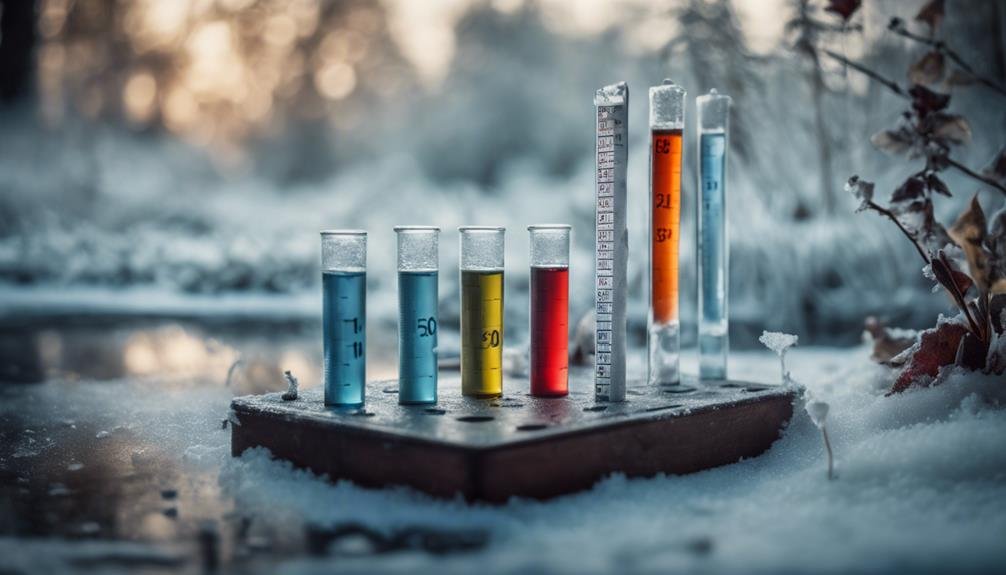To properly test pond water in winter, it is crucial to have the right tools on hand. A dissolved oxygen meter is essential for checking oxygen levels, which are vital for the survival of aquatic life. Additionally, a pH meter should be used to assess water acidity, ideally falling between 6.5 and 8.5.
Monitoring temperature fluctuations that impact oxygen levels can be done with a thermometer. Using a Secchi disk to measure water clarity and test kits to analyze nutrient concentrations such as phosphates and nitrates from runoff or decaying matter is also important.
Regular testing every 4-6 weeks is crucial, especially during winter when ice cover can hinder gas exchange. Taking preventative steps such as using de-icing tools and aeration can help increase oxygen levels, ultimately preventing fish kills.
By following proactive maintenance techniques, you can ensure a thriving winter pond ecosystem. For more detailed guidance on maintaining your pond during winter, explore our comprehensive guide.
Winter Pond Monitoring
Monitoring pond conditions in winter is crucial for anticipating potential issues before spring. It's essential to keep an eye on ice cover, water levels, and any signs of distress in surrounding vegetation and wildlife. Thick ice can hinder gas exchange, leading to low oxygen levels that can harm fish and other aquatic life.
Regularly checking dissolved oxygen levels is vital, especially if there are aeration systems in place under the ice. If oxygen levels are severely depleted, immediate action may be needed, such as creating holes in the ice or adding aerators.
Monitoring water levels is also important, as significant drops could indicate a leak that requires immediate attention. Observing shoreline vegetation can provide valuable insights into nutrient imbalances or pollutants entering the pond from runoff. Dead foliage or algal blooms visible amidst the snow and ice may indicate underlying water quality issues that need further investigation.
Keeping an eye on mammal and bird activity around the pond can help identify any issues affecting the local ecosystem. Being vigilant during winter allows for timely interventions to maintain a healthy pond ecosystem when spring arrives.
Required Testing Equipment
To effectively monitor your pond during winter, it's crucial to have the right testing equipment. A dissolved oxygen meter is essential for measuring oxygen levels, which are vital for the well-being of aquatic life. Low oxygen levels can harm fish and other organisms, so keeping track of this parameter is crucial.
A pH meter is also necessary to check the water's acidity, as extreme pH levels can disrupt biological processes. Additionally, having a thermometer on hand to monitor temperature changes is important as it affects oxygen levels and metabolic rates.
Using a secchi disk, a weighted disk that measures water clarity, can help you assess turbidity levels in your pond. High turbidity can block sunlight and hinder photosynthesis, impacting the overall health of the ecosystem.
Test kits for monitoring levels of ammonia, nitrites, and nitrates are also recommended as excess nutrients can lead to algal blooms, disrupting the pond's balance. Depending on the size and depth of your pond, you may need a sampling pole or boat to access different areas safely for testing.
Dissolved Oxygen Levels

Testing the dissolved oxygen levels in the pond water during winter is crucial for the well-being of aquatic life. Adequate oxygen is necessary for their survival, making close monitoring essential.
To accurately measure the oxygen concentration, we've options like chemical test kits or electronic meters available. These methods will help us ensure that the oxygen levels in the pond are at optimal levels for the aquatic organisms to thrive.
It's important to stay vigilant and proactive in maintaining a healthy environment for the aquatic life in the pond, especially during the winter months when oxygen levels can fluctuate.
Oxygen Requirements
During winter, ensuring sufficient oxygen levels in ponds is crucial for the survival of aquatic life. It's essential to monitor and maintain adequate dissolved oxygen concentrations, as low levels can be harmful, even fatal to pond inhabitants.
Different species have varying oxygen needs, but as a general rule, dissolved oxygen levels above 5 parts per million (ppm) are ideal. Cold-water fish like trout and koi can tolerate levels as low as 3 ppm, while warm-water species such as bass and bluegill struggle below 5 ppm. Higher oxygen content is always better for the overall health of the ecosystem.
Various factors affect oxygen levels, including water temperature, decomposition of organic matter, and rates of photosynthesis. Ice and snow covering the pond reduce light penetration, which hinders plants' ability to produce oxygen through photosynthesis. At the same time, decomposing organic matter uses up available oxygen.
Monitoring these factors allows us to take proactive steps like aeration or removing part of the ice to maintain sufficient dissolved oxygen levels throughout winter.
It's important to remember that maintaining adequate oxygen levels in ponds during winter is crucial for the well-being of the aquatic ecosystem. By staying vigilant and taking necessary actions, we can ensure the survival and health of pond inhabitants even in the coldest months.
Testing Methods
In order to accurately measure dissolved oxygen levels, it's essential to utilize reliable testing methods. The most common and efficient approach is to use a dissolved oxygen meter, a specialized tool designed for this purpose. This meter is equipped with a probe that's submerged into the pond, enabling it to analyze the water and provide precise readings of oxygen concentration.
Alternatively, the Winkler titration technique can also be used for testing dissolved oxygen levels. This method involves adding specific chemical reagents to a water sample and then titrating it to determine the oxygen levels present. Although accurate, this technique requires more equipment and expertise compared to using a dissolved oxygen meter.
Regardless of the method chosen, it's crucial to carefully follow the manufacturer's instructions to ensure accurate results. Factors such as temperature, depth, and time of day should also be taken into consideration when conducting tests, as these variables can impact dissolved oxygen levels in ponds.
Measuring Water Ph
During winter pond testing, it's crucial to monitor the water's pH level as it can impact the pond's ecosystem and the life within it. An imbalanced pH can harm fish, plants, and other aquatic organisms.
To measure pH, we can use a testing kit from pet or pond supply stores. These kits usually contain test strips or a liquid solution that changes color based on the water's acidity or alkalinity. By dipping the test strip or adding a few drops of the solution to a sample of pond water, we can compare the resulting color to a provided chart to determine the pH level.
For most ponds, the ideal pH range is between 6.5 and 8.5. If the readings fall outside this range, we may need to adjust the pH using chemical additives or aeration techniques.
Monitoring pH closely during winter is essential, as stagnant conditions can lead to fluctuations that harm the pond ecosystem. Regular testing and adjustments can help maintain a healthy and balanced pond throughout the colder months.
Ammonia Concentration Check

Testing for ammonia levels is crucial alongside pH checks to ensure the health of pond life. Ammonia, a harmful compound produced by fish waste and decaying matter, can reach dangerous levels without detection. Since ammonia is both colorless and odorless, a test kit is necessary for monitoring.
This kit typically involves dipping a test tube into the pond water and adding specific reagents that trigger a color change. By comparing this color to a reference chart, we can determine the ammonia concentration. Ideally, the level should be close to 0 parts per million (ppm), as anything above 0.25 ppm can begin harming aquatic life.
In the event of high ammonia levels, a partial water change may be necessary to dilute the concentration. Additionally, introducing beneficial bacteria that consume ammonia can help reduce levels gradually. By consistently testing and maintaining the pond, we can effectively manage ammonia levels and safeguard the ecosystem during the dormant winter period.
Nutrient Load Assessment
Understanding a pond's nutrient load is crucial for maintaining its ecosystem balance. By testing for phosphates and nitrates, we can pinpoint potential issues such as excessive algal growth and oxygen depletion. Phosphates mainly stem from decaying organic matter, fertilizer runoff, and waterfowl waste, while nitrates have similar sources and can indicate the risk of eutrophication.
For optimal pond health, the ideal range for phosphates is between 0.01-0.03 ppm, while nitrates should ideally be kept below 40 ppm. Elevated levels of these nutrients can lead to problems like algal blooms and fish stress or toxicity.
To assess nutrient levels, water samples can be collected and tested using kits or sent to a lab for analysis. If levels are found to be high, interventions such as aeration, planting buffers, or chemical treatments may be necessary to restore balance.
Regularly monitoring nutrient levels in the pond allows for early detection of issues and the timely implementation of preventive measures. By staying proactive in managing nutrient loads, pond owners can help maintain a healthy and thriving aquatic environment.
Testing Frequency Guidelines

Regular testing is crucial for monitoring nutrient levels in your pond, especially during the winter months when fluctuations are common. We recommend testing your pond water every four to six weeks to ensure that any imbalances are detected and addressed promptly.
Factors like reduced biological activity and changes in water chemistry can impact nutrient levels during this time, making regular testing essential.
Key parameters to focus on during testing include pH, ammonia, nitrite, nitrate, and phosphate levels. These indicators offer valuable insights into your pond's overall health and can help you determine if any corrective actions, such as water treatments or aeration, are necessary.
Adjusting your testing schedule based on specific pond conditions and observed changes is also important to maintain a healthy ecosystem.
Preventative Maintenance Steps
Let's discuss two key maintenance techniques to keep your pond in top condition: de-icing and aeration. De-icing tools like bubblers, heaters, and rakes are essential for preventing ice buildup, ensuring proper gas exchange for aquatic life.
On the other hand, aeration methods such as diffusers and fountains are excellent for increasing oxygen levels and supporting beneficial bacteria, maintaining a healthy pond ecosystem throughout the winter months.
These strategies are crucial for the well-being of your pond and its inhabitants, so implementing them is highly recommended to avoid potential issues.
De-Icing Techniques
To prevent ice buildup in the testing area during winter, it's crucial to employ effective de-icing methods. There are several approaches that can be used to maintain access to the pond for testing purposes.
One option is to use floating de-icers, which help circulate water to prevent freezing in specific areas.
Another method is to spread rock salt or calcium chloride around the testing site to lower the freezing point of water.
Additionally, insulating covers made of materials like burlap or foam can be placed over the area to retain heat and prevent ice formation.
Heating cables or mats submerged in the pond can also be utilized to warm a section and prevent freezing.
When implementing these de-icing techniques, it's important to consider the potential environmental impact, especially when using chemicals or heat sources. Prioritizing eco-friendly options and following manufacturer instructions diligently can help avoid harm to the pond ecosystem. Regular monitoring and adjustments may be necessary to ensure the testing area remains free of ice throughout the winter months.
Aeration Strategies
To maintain healthy pond water during winter, it's essential to consider aeration strategies alongside de-icing methods. Proper aeration helps prevent the formation of oxygen-depleted areas under the ice, which can harm fish and promote algal blooms.
One effective method is installing a submersible aeration system that uses an air pump to circulate oxygen-rich water from the surface to the bottom of the pond. Another option is using a floating aerator that stirs up the water's surface to increase oxygen levels.
Creating an opening in the ice is another helpful strategy for gas exchange between the water and air. This can be achieved with a pond de-icer or by manually removing some ice. However, precautions should be taken to prevent the opening from freezing over again. Regular monitoring and maintenance are crucial.
Conclusion
Regular winter monitoring is essential for maintaining the health of ponds, just like the one in Central Park that supports diverse aquatic life. During this time, it's crucial to test key parameters such as dissolved oxygen, pH, and ammonia levels to ensure a balanced environment.
By monitoring nutrient loads consistently, we can take proactive measures to prevent issues like algal blooms or fish die-offs. With the right equipment and a consistent schedule, we can uphold optimal conditions in the pond until the arrival of spring.

